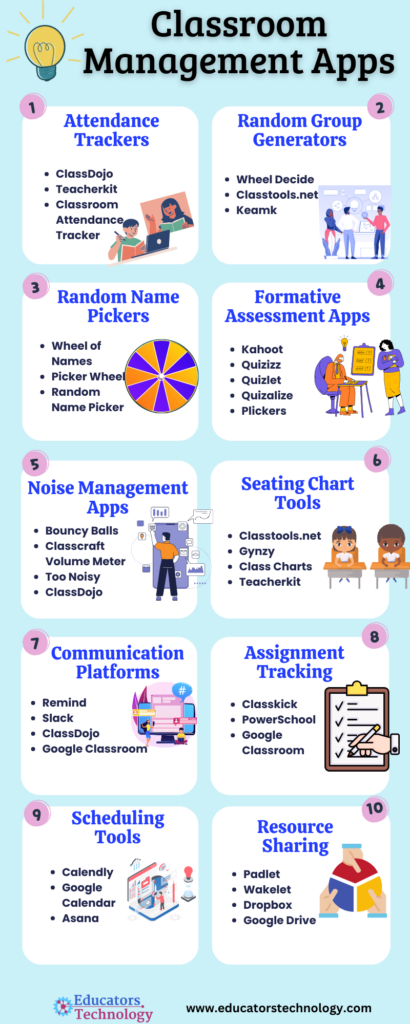
Over the years, I’ve had the privilege of exploring and reviewing hundreds of educational tools and apps, each with its unique potential to transform classroom dynamics. The journey through this digital landscape has been enlightening, revealing the immense possibilities that technology can offer in enhancing educational experiences.
In this post, I’ve distilled the essence of my explorations, handpicking the best tools that stand out for their ability to streamline classroom management. These are tools that I believe will bring efficiency, engagement, and structure to your educational environment.
Navigating through the multitude of available apps can be overwhelming, which is why I’ve carefully organized these top selections into specific categories, each targeting a particular aspect of classroom management. From Attendance Trackers that ensure precision and ease in monitoring presence, to Resource Sharing and Collaboration Tools that foster cooperative learning and innovation, each category is a trove of carefully chosen apps.
These tools are the culmination of rigorous scrutiny and real-world testing, chosen to offer you a seamless blend of functionality and reliability. I have also included a free infographic at the bottom of the page capturing all the classroom management apps I shared here.
Related: Best Classroom Management Books
Classroom Management Apps
To streamline your navigation through this post, I’ve meticulously organized the content into distinct categories. For your convenience, these categories are neatly laid out in the table of contents below. Simply click on the category of your choice to swiftly access the information you need. This way, you can effortlessly explore the tools and insights that are most relevant to your classroom management needs.
- Classroom Management Apps
- 1. Attendance Trackers
- 2. Random Group Generators
- 3. Random Name Pickers
- 4. Formative Assessment Apps
- 5. Classroom Noise Management Apps
- 6. Classroom Organization and Seating Chart Tools
- 7. Communication Platforms
- 8. Assignment Tracking and Submission Apps
- 9. Time Management and Scheduling Tools
- 10. Resource Sharing and Collaboration Tools
- Final thoughts
1. Attendance Trackers
Maintaining accurate attendance records is not just a bureaucratic necessity but a vital part of student management and engagement. Advanced attendance trackers have revolutionized this aspect of classroom management, offering sophisticated yet user-friendly solutions. Here are some of good tools that have been instrumental in streamlining the attendance tracking process:
- Classroom AttendanceTracker: Seamlessly integrating with Google Classroom, Google Sheets, and Google Forms, Classroom Attendance Tracker automates the attendance-taking process by scheduling and sending daily attendance forms to students. The responses are then efficiently compiled into a centralized Google Sheet, offering a streamlined solution while still allowing for manual oversight to ensure the accuracy and integrity of attendance records.
- Attendance by ClassDojo: Known for its broader classroom management features, Attendance by ClassDojo also offers a specific module for attendance tracking. It stands out with its engaging interface, allowing teachers to quickly mark students as present, absent, or late.
- TeacherKit: Primarily a classroom management app, TeacherKit also offers features for organizing physical spaces. Teachers can track attendance, behavior, and grades, and also create seating charts. Its user-friendly interface and comprehensive features make it a one-stop-shop for classroom organization.
2. Random Group Generators
The ability to form groups quickly and fairly can significantly enhance the learning experience. Random Group Generators are invaluable tools in this context, fostering collaboration and ensuring a balanced mix of students for group activities, discussions, or projects. These digital tools not only save time but also inject an element of impartiality and surprise into the group formation process. Here’s a look at some of the top random group generators out there:
- 1. Random Group Generator by Classtools: This intuitive tool simplifies group creation in the classroom. Teachers input their class list, specify the desired number of groups, and with a click, evenly distributed teams are formed. The ability to create up to 20 groups makes it versatile for various class sizes and activities.
- 2. Keamk: Keamk stands out with its detailed group-making features. Beyond random allocation, it allows teachers to assign scores or genders to participants, ensuring balanced and diverse groups.
- 3. Random Group Creator (by Aschool): By entering a list of names and specifying the number of desired groups, teachers can quickly generate random groups for classroom activities. Aschool also offers a unique feature with its Random Group Mixer Creator, ideal for inter-grade activities, ensuring a seamless blend of different student groups.
- 4. Wheel Decide: More than just a group generator, Wheel Decide adds an element of fun and unpredictability to the process of team formation. Teachers can enter student names and use the digital wheel to select group members one by one. While it serves broader purposes like decision making and games, its use as a group generator introduces a dynamic, interactive element to the classroom.
3. Random Name Pickers
Random Name Pickers offer a unique blend of functionality and entertainment, transforming routine classroom tasks into engaging and interactive experiences. These tools are not only about the randomness in selection but also about adding an element of surprise, fairness, and enjoyment to everyday classroom activities. From selecting students for tasks, forming groups, or even distributing rewards, Random Name Pickers inject a sense of anticipation and excitement into the learning environment. Here’s a closer look at some of the tools that make this possible:
- Rand Name Picker by ClassTools: This is simple and easy to operate. Type in the names of students, click on submit then click on the wheel to start spinning. Once the selected name is displayed, the tool asks whether you want to remove the chosen name or not. You can edit and save your list, share it with others or embed it in your blog or class website.
- Wheel of Names: Another good random name picking tool for classrooms. Teachers can enter student names and let the wheel decide, turning the otherwise routine task of group formation or turn-taking into an exciting event. The ability to customize the wheel with colors, sounds, and spin time allows teachers to tailor the experience to their class’s mood or the specific activity, making it a versatile and enjoyable tool for both students and teachers.
- Picker Wheel: Similar to Wheel of Names and Wheel Decide, Picker Wheel offers a straightforward and visually engaging way to select names or form groups. Its user-friendly interface allows teachers to input student names and simply spin the wheel to generate results.

4. Formative Assessment Apps
Formative assessment apps provide interactive, efficient ways for teachers to gauge student understanding in real-time and tailor their instruction accordingly. Here are some notable examples:
- Kahoot!: Kahoot! is a game-based learning platform that brings engagement and fun to learners at school, at work, and at home. Teachers can create quizzes, discussions, or surveys (kahoots) in seconds and students can respond on their devices. It’s renowned for its interactive, game-like atmosphere which can boost student participation and motivation.
- Quizizz: Quizizz allows teachers to conduct student-paced formative assessments in a fun and engaging way. Teachers can create their own quizzes or choose from millions of teacher-created quizzes. Its features include interactive quizzes with embedded memes for correct/incorrect answers, and detailed class and student-level reports.
- Formative: Formative goes beyond multiple-choice; it allows students to draw, type, or submit images to showcase their understanding. Teachers get live feedback and can track student progress over time. Its versatility in question types and real-time feedback system makes it a powerful tool for in-the-moment assessment and learning adjustments.
- Socrative: Socrative is a real-time feedback tool that is simple and intuitive for both teachers and students. Teachers can create quizzes, quick question polls, exit tickets, and space races which are fun, competitive team activities. Socrative provides immediate feedback and visualizes student understanding, helping teachers to adjust their teaching strategy as needed.
- Plickers: Plickers is a unique formative assessment tool for classrooms that don’t have one-to-one devices. Teachers can print a set of Plicker cards, students hold up their card to answer questions, and the teacher scans them with a smartphone or tablet. It’s a simple and quick way to check student understanding without the need for student devices.
Related: Classroom Management Annotated Bibliography
5. Classroom Noise Management Apps
Classroom noise management apps are essential tools in maintaining a conducive learning atmosphere. These innovative solutions help educators monitor and control the ambient noise level, ensuring that the classroom remains a focused, effective, and engaging space for learning. By providing real-time feedback and interactive features, these apps play a crucial role in helping students self-regulate their noise levels, fostering a collaborative yet orderly classroom environment. Here’s an overview of some standout apps in this category:
- Bouncy Balls: Bouncy Balls is a user-friendly, web-based noise monitoring tool perfect for classrooms. It features a noise meter that reacts to ambient noise levels, visually represented by animated balls that bounce increasingly higher as noise levels rise. This intuitive visual feedback helps students self-regulate their noise levels. It’s free, requires no registration or downloads, and is celebrated for its simplicity and effectiveness.
- Classcraft Volume Meter: Part of the broader Classcraft gamified learning platform, the Volume Meter is a tool specifically designed to monitor classroom noise. It provides real-time visual feedback through a horizontal bar that fluctuates with noise levels, helping students be aware of and control their volume. It’s free, requires no registration, and includes additional features like a timer for classroom activities, with more advanced features available for premium users.
- Classroom Noise ‘O’Meter: A creative project built on the Scratch coding platform, this tool visualizes noise levels with a clock-like display where the hand moves to represent increasing noise, color-coded from green (low noise) to red (high noise). It leverages the computer’s microphone to gauge ambient noise and offers a unique educational twist by being part of the Scratch community, where users can create and share their own remixes of the original project.
- ClassDojo: Known primarily for its behavior tracking and classroom management features, ClassDojo also includes a noise meter. The tool features adjustable sensitivity and visual columns that fluctuate with noise, providing clear, real-time feedback. Accessible through a ClassDojo account, this tool integrates noise management with broader classroom management functionalities.
- Too Noisy: This versatile noise meter app is compatible with various devices and offers a range of features to engage students and manage noise levels. Visual backgrounds change in response to noise, and the tool includes an alarm counter, star rewards for maintaining acceptable noise levels, and an attention-grabbing ‘screen shatter’ effect and audible alarm when noise exceeds the set threshold. These interactive and customizable features make Too Noisy an engaging tool for maintaining a conducive learning environment.
6. Classroom Organization and Seating Chart Tools
Classroom organization and seating chart tools are essential for teachers to create a structured and conducive learning environment. These tools not only assist in the physical arrangement of the classroom but also offer solutions to manage and optimize the learning environment, ensuring that both the space and the students are organized and primed for educational success.Here are some examples of tools that can help in efficiently managing classroom space and resources:
- Seating Plan Generator: The Classtools.net Seating Plan Generator is a refreshingly straightforward and efficient tool for educators aiming to organize their classroom layouts with ease. Its user-friendly interface allows for the input of up to 25 student names, offering a quick and personalized seating chart solution.
- Gynzy: Gynzy’s Classroom Seating Chart offers a dynamic and interactive way to design and manage classroom seating arrangements. This tool simplifies classroom organization, promoting an engaging learning environment. With features like realistic classroom layouts, drag-and-drop student name placement, and customizable furniture and decorations, teachers can easily create and save multiple seating chart templates.
- TeacherKit: Primarily a classroom management app, TeacherKit also offers features for organizing physical spaces. Teachers can track attendance, behavior, and grades, and also create seating charts. Its user-friendly interface and comprehensive features make it a one-stop-shop for classroom organization.
- Class Charts: Combining seating charts with behavior management, Class Charts helps teachers make informed decisions about their classroom layout. It uses data on student behavior to suggest the most effective seating arrangements, aiming to improve student interactions and engagement.

7. Communication Platforms
Communication platforms are pivotal in ensuring a seamless connection between teachers, students, and parents, fostering a collaborative and informed educational environment. Besdides popular platforms such as Google Classroom and Schoology, here are some other tools that excel in facilitating communication within the educational sphere:
- Remind: A popular platform designed specifically for education, Remind allows teachers to send messages, announcements, and reminders to students and parents. Its features include the ability to send one-way announcements or engage in two-way conversations, schedule messages in advance, and even translate messages into various languages, ensuring inclusivity and accessibility.
- ClassDojo: ClassDojo is widely appreciated for creating community within classrooms. It offers real-time messaging features, allowing teachers to share photos, videos, and announcements. Parents and students can respond or react to these updates, creating an interactive and engaging platform for school-home communication.
- Slack: Slack is a communication platform offering many IRC-style features, including persistent chat rooms (channels) organized by topic, private groups, and direct messaging. While it’s more popular in business settings, it’s also an effective tool for higher education settings, facilitating communication and file sharing between students working on group projects or between students and professors.
8. Assignment Tracking and Submission Apps
Assignment tracking and submission apps streamline the process of managing coursework, enhancing the efficiency of collecting, reviewing, and grading student work. Here are some exemplary tools in this category:
- Google Classroom: A staple in many educational institutions, Google Classroom simplifies the creation, distribution, and grading of assignments. It offers a cohesive platform for sharing resources, submitting assignments, and providing feedback. The integration with other Google tools like Docs, Sheets, and Drive makes it a versatile and comprehensive solution for assignment management.
- PowerSchool: Known for its collaborative and interactive approach, PowerSchool offers a suite of tools for assignment tracking and submission. It supports multimedia assignments, personalized learning paths, and has robust analytics to track student progress and engagement. Its integration with a wide range of educational tools and apps makes it a flexible choice for diverse learning environments.
- Classkick: Classkick is a learning platform that is available both on the web and as an app. Classkick helps you take your classroom to the cloud, offering a paperless, real-time interactive experience for your students. Once you set up your class there, you will be able to access educational resources tailored for teachers, video content, assignments, and much more. You can effortlessly upload your existing materials or create fresh content using a rich array of tools including drawings, text, links, images, audio, and videos.
These apps not only facilitate the logistical aspects of assignment management but also enhance the interaction and feedback quality between teachers and students, contributing to a more organized, engaging, and productive learning experience.
9. Time Management and Scheduling Tools
Time management and scheduling tools are pivotal for maintaining an organized and efficient educational environment. Here are some applications that stand out for their ability to assist educators in planning classes, tracking appointments, and optimizing time management in the classroom:
- Google Calendar: A widely-used tool, Google Calendar is known for its simplicity and integration with other Google services. It allows educators to schedule classes, set reminders for assignments, and create events for meetings or parent-teacher conferences. Its sharing features make it easy to coordinate schedules with colleagues and students.
- Calendly: Calendly simplifies the process of setting appointments, making it a handy tool for educators who regularly schedule meetings with students, parents, or colleagues. It allows others to choose available times based on the user’s settings, automating the scheduling process and integrating with personal calendars to prevent double-booking.
- Asana: Asana is a flexible project management tool that can be adapted for classroom time management and scheduling. Teachers can create tasks for lesson plans, track progress on educational projects, and set deadlines. Its calendar view and integration with various communication tools make it a comprehensive solution for managing classroom activities and timelines.
These tools offer a range of functionalities to suit different organizational styles and preferences, ensuring that educators can keep track of their schedules, plan effectively, and make the best use of their time and resources in the classroom.
10. Resource Sharing and Collaboration Tools
Resource sharing and collaboration tools are crucial for fostering a dynamic, interactive, and cooperative learning environment. They enable educators and students to work together seamlessly, share educational materials, and engage in group projects. Here are some top tools in this category:
- Google Drive: Google Drive is a cloud-based storage platform that allows users to save files online and access them from any smartphone, tablet, or computer. It’s particularly effective for educational collaboration, as it supports sharing of documents, spreadsheets, and presentations, and enables real-time editing and commenting.
- Dropbox: Dropbox is a file hosting service offering cloud storage, file synchronization, personal cloud, and client software. It’s particularly useful for sharing large files or folders that might be too big to email. Dropbox allows both teachers and students to access materials from any location, facilitating remote learning and collaboration.
- Padlet: Padlet is an online virtual bulletin board where students and teachers can collaborate, reflect, share links and pictures, in a secure location. It’s an excellent tool for creating a sense of community, sharing resources, and facilitating discussions in an engaging and visual way.

Final thoughts
As I mentioned before, the classroom management apps I shared in this post are the distilled essence of years of exploration and hands-on experience, selected to empower you in the art of classroom management. As you integrate these tools into your teaching practice, remember that they are not just about streamlining administrative tasks or organizing content; they are about enriching the educational journey for you and your students, fostering a more engaging, inclusive, and effective learning environment.
As you explore these tools, I encourage you to approach them with curiosity and creativity, adapting them to fit the unique needs and dynamics of your classroom. Technology in education is ever-evolving, and staying adaptable and open to new possibilities can lead to wonderfully innovative teaching and learning experiences. So, whether you’re synchronizing schedules, managing classroom noise, or fostering collaboration among your students, know that these tools are here to support you every step of the way.
The post Best Classroom Management Apps appeared first on Educators Technology.
Title: Best Classroom Management Apps
URL: https://www.educatorstechnology.com/2024/02/classroom-management-apps.html
Source: Educational Technology
Source URL: https://www.educatorstechnology.com
Date: February 6, 2024 at 01:14AM
Feedly Board(s): Schule